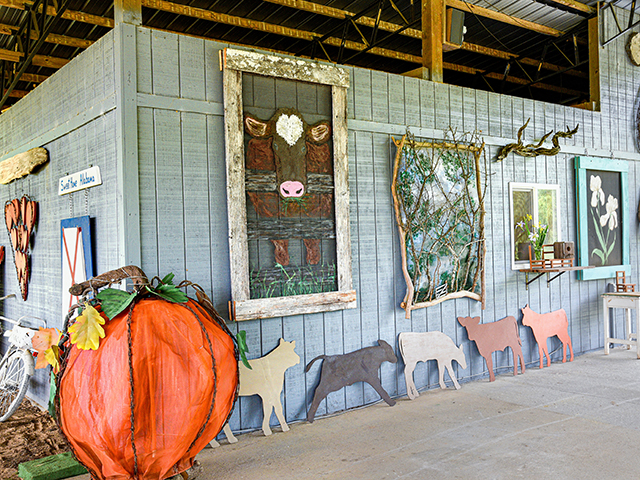Art Is Where You Find It
Art Is Everywhere
Frequent travelers on Autauga County Road 4 in central Alabama know to expect the unusual when they see the 3L Ranch sign. That's because cattle producer Linda Lipscomb uses discarded window screens, rusty tin and fence wire to celebrate the changing seasons and serve as an outlet for her creativity.
She first decorated the utilitarian sign in the 1980s using an American flag made from wood slats and barbed wire. Since then, there have been oversized valentines made of corrugated tin, pumpkins and watermelons fashioned from screen, as well as a detailed farm scene with a miniature farm gate.
"Somebody will be driving by and honk the horn and wave or pull over and say something to let me know they appreciate it. That makes me feel good," Linda says.
The 64-year-old's path to 3L Ranch artist-in-residence has not been short or easy. Her father was a full-time farmer and her mother a homemaker. The money wasn't there for extracurricular activities for her or her older siblings, Bill and Pat. But, the three soaked up artistry from both of their parents.
"Mama doodled on scraps of paper," Linda says. "I wish I had saved some of them."
Her father recycled leather from worn-out or outgrown boots, turning it into intricately carved bridle reins.
P[L1] D[0x0] M[300x250] OOP[F] ADUNIT[] T[]
Looking back, Linda says an event intended to discipline the children wound up being the source of so much of their later artistic talents.
Her brother, Bill, recalls that "after school, Linda and I were supposed to do our homework and then chores. Daddy came in one afternoon and caught us watching cartoons on TV. He unplugged that TV and told us to get in the truck. He never said a word, but he drove to a neighbor's and gave him the TV. We had to be creative then."
GROWING UP ON ART
One of Linda's first attempts at art was a horse head she sketched on plywood and cut out with a handsaw. She won third place at the county fair. "I was maybe 10 years old and thrilled," she recalls.
High school was a struggle for Linda, but she enjoyed working part-time at a frame shop in Prattville. She stayed there for two years after graduation, recalling how it let her see, touch and feel real art. Next, she went to work at the local paper mill, now International Paper. It was about the same time her father died, and she and Bill took over the family farm. They both continued to work full-time jobs, and she still made time for art lessons at the Prattville Center for the Arts.
THE LURE OF SUCCESS
In 2007, Linda's passion and artistic ability got the attention of a co-worker, who urged her to enter a contest to decorate a giant fiberglass fishing lure. The project was used to raise money for parks along the Alabama River, which borders 3L Ranch. Linda submitted a sketch for her idea, titled "Allure of the River," and was one of 30 artists chosen to produce the work. Her employer sponsored her lure.
From July until the end of August, Linda worked frantically on nights and weekends to fill the piece with detailed acrylic paintings of wild turkey, deer, wildflowers and river scenes. When the lures were lined up on the Montgomery riverfront, pedestrians were invited to vote for their favorite. The still-shocked Linda says, "A lot of different people from all walks of life gave me the People's Choice award."
Sister, Pat Joyner, had no trouble believing it or that Linda has fans for the rest of her work. "It is all homey -- there is a pride of place. People find it relatable," she says.
For the next decade, Linda continued to create farm signs, make tables from rattan vines and hammer out unique birdhouses. This while working full time at the mill, sharing chores on the 100-cow commercial herd farm and serving as one of her mama's main caregivers when her health declined.
When asked to name her favorite piece, Linda picks two. One is a sign she made in memory of her father, Forest. It is a mixed-media scene that includes wood from the farm. The other is a giant iris, in memory of her mother, Iris, who passed away in 2014.
In 2018, life began to get a bit less complicated when Linda retired. Now, as Bill says, "We're in a contest to work each other to death on cattle projects."
But, with the work, there's always more. A short trip to a pasture to move cows can turn into a wildflower-identifying session. Those flowers are likely to end up in Linda's art.
Flowers, she adds, are just another form of art and therapy, she says. She spends hours in her yard keeping the flowers growing, creating beauty along with nature.
So, what is art for an Alabama cattlewoman? Whether it is her daylily bed, a rusty fountain or her road signs, Linda says it's really simple: "Art is where you find it."
[PF_0921]
(c) Copyright 2021 DTN, LLC. All rights reserved.




